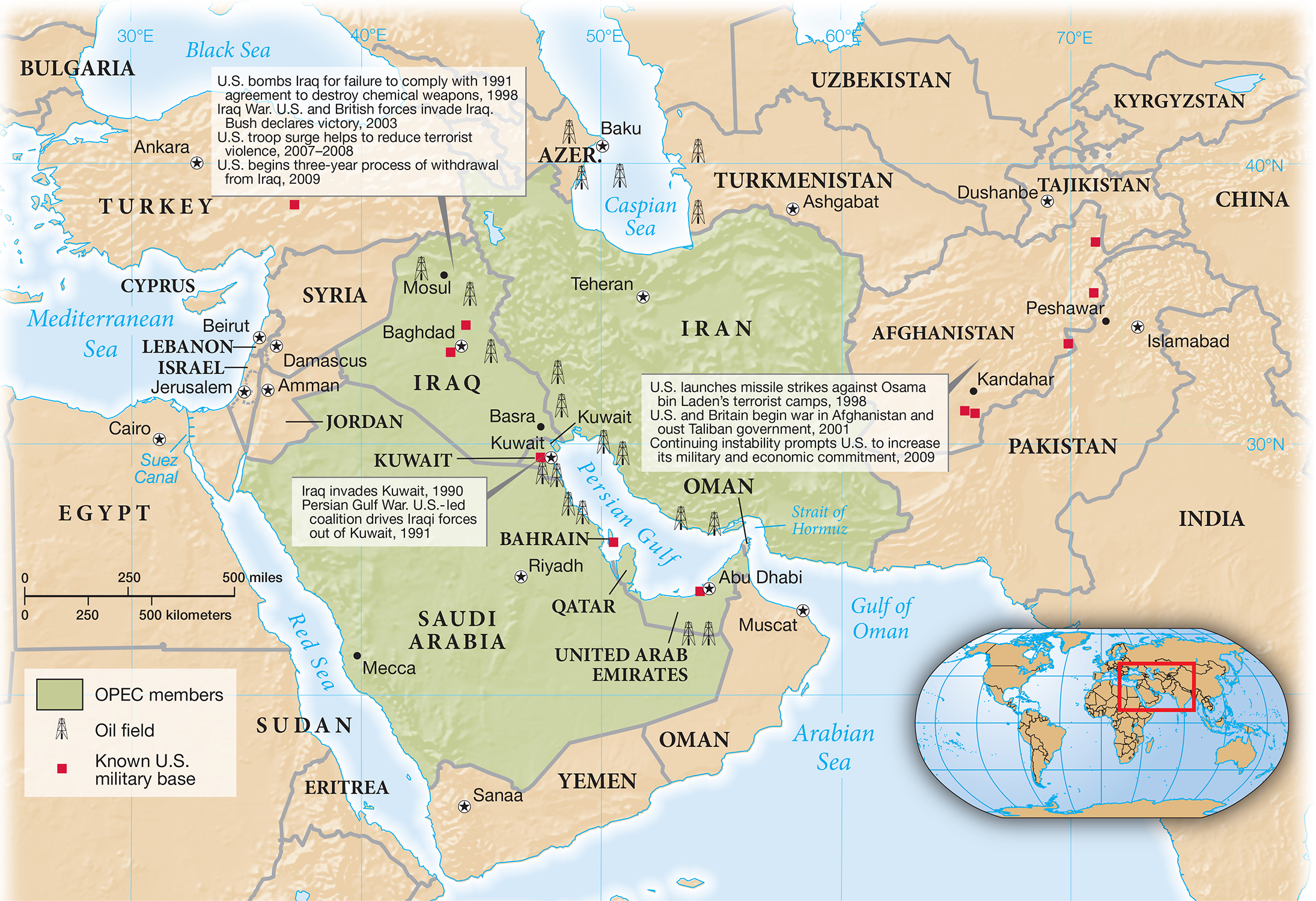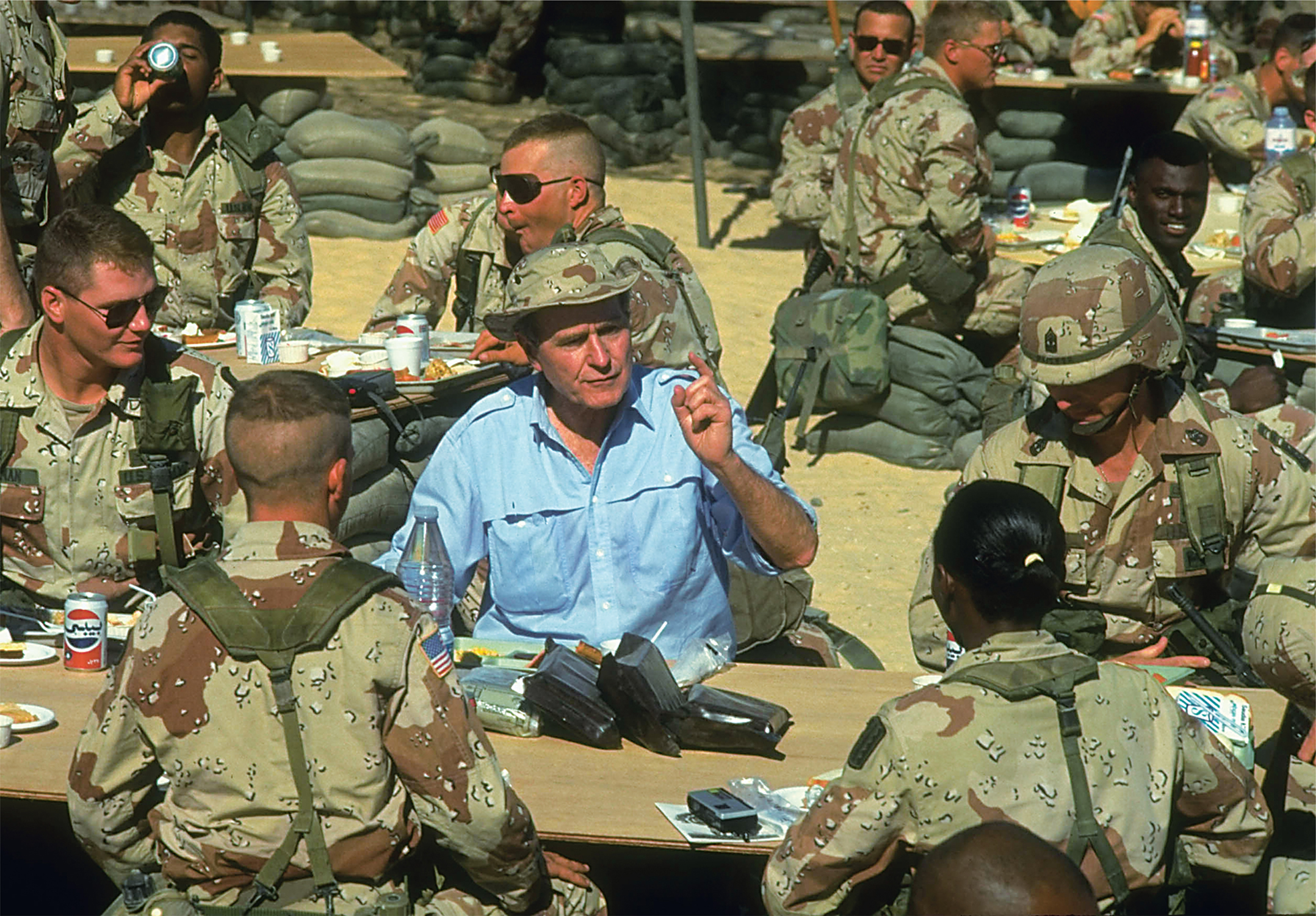Going to War in Central America and the Persian Gulf
Near its borders, the United States continued to exercise its military power. In Central America, U.S. officials had developed close ties to Panamanian dictator Manuel Noriega whom they valued for his anticommunism. But in 1989, after an American grand jury indicted Noriega for drug trafficking and after his troops killed an American Marine, Bush ordered 25,000 military personnel into Panama. U.S. forces quickly overcame Noriega’s troops, sustaining 23 deaths, while hundreds of Panamanians, including many civilians, died. Colin Powell noted that “our euphoria over our victory was not universal.” Both the United Nations and the Organization of American States censured the unilateral action by the United States.
By contrast, Bush’s second military engagement rested solidly on international approval. Viewing Iran as America’s major enemy in the Middle East, U.S. officials had quietly assisted the Iraqi dictator Saddam Hussein in the Iran-Iraq war, which began in 1980 and ended inconclusively in 1988. In August 1990, Hussein invaded the small country of Kuwait (Map 31.2), and his troops soon neared the Saudi Arabian border, threatening the world’s largest oil reserves. President Bush quickly ordered a massive military mobilization and assembled an international coalition to stand up to Iraq. He invoked principles of national self-determination and international law, but access to Middle Eastern oil was also a key concern.

MAP ACTIVITY Map 31.2 Events in the Middle East, 1989–2011 The Arab League supported the war to liberate Kuwait in 1991, and after September 11, 2001, it also approved of U.S. military operations in Afghanistan. Yet only the countries where the United States had military bases supported the American invasion of Iraq in 2003. Arab hostility toward the United States also reflected the deterioration of Israeli-Palestinian relations after 1999. READING THE MAP: In what countries are the sources of oil located? In what countries does the United States have military bases? CONNECTIONS: What conditions prompted the U.S. military interventions in Iraq and Afghanistan in 1991, 2001, and 2003? What were the U.S. goals in each of these interventions? To what extent were those goals realized?
Reflecting the easing of Cold War tensions, the Soviet Union supported a UN embargo on Iraqi oil and authorization for using force if Iraq did not withdraw from Kuwait by January 15, 1991. By then, the United States had deployed more than 400,000 soldiers to Saudi Arabia, joined by 265,000 troops from two dozen other nations, including several Arab states. “The community of nations has resolutely gathered to condemn and repel lawless aggression,” Bush announced. “With few exceptions, the world now stands as one.”
When the UN-imposed deadline for Iraqi withdrawal expired, Bush asked Congress to approve war. Many legislators favored waiting to see whether the embargo would force Hussein to back down, a position quietly urged within the administration by Colin Powell. Congress debated for three days and then authorized war by a margin of five votes in the Senate and sixty-seven in the House, with most Democrats opposed. On January 17, 1991, U.S. forces led a forty-day bombing campaign against Iraqi military targets, power plants, oil refineries, and transportation networks. Having severely crippled Iraq by air, the coalition then stormed into Kuwait, forcing Iraqi troops to withdraw (see Map 31.2).
“By God, we’ve kicked the Vietnam syndrome once and for all,” President Bush exulted on March 1. Most Americans found no moral ambiguity in the Persian Gulf War and took pride in the display of military prowess. The United States stood at the apex of global leadership, steering a coalition in which Arab nations fought beside their former colonial rulers.

The Gulf War On Thanksgiving 1990, during the buildup to the Gulf War, President George H. W. Bush visited U.S. troops deployed to Saudi Arabia. Here he talks with a woman, one of 33,000 stationed throughout the area. For the first time, women served in combat support positions, piloting planes and helicopters, directing artillery, and fighting fires. Time & Life Pictures/Getty Images.
Some Americans wondered why the Bush administration ended the war without deposing Hussein. Bush pointed to the limited UN mandate and to Middle Eastern leaders’ concerns that invading Iraq would destabilize the region. His secretary of defense, Richard Cheney, doubted that a stable government could be created to replace Hussein and considered the price of a long occupation too high. Instead, administration officials counted on Hussein’s pledge not to rearm or develop weapons of mass destruction, secured by a system of UN inspections, to contain him.
Yet Middle Eastern stability remained elusive. Israel, which had endured Iraqi missile attacks, was more secure, but the Israeli-Palestinian conflict seethed. Despite military losses, Hussein remained in power and turned his war machine on Iraqi Kurds and Shiite Muslims whom the United States had encouraged to rebel. Hussein also found ways to conceal arms from UN weapons inspectors before he threw the inspectors out in 1998. Finally, the decision to keep U.S. troops based in Saudi Arabia, the holy land of Islam, fueled the hatred and determination of Muslim extremists like Osama bin Laden.

